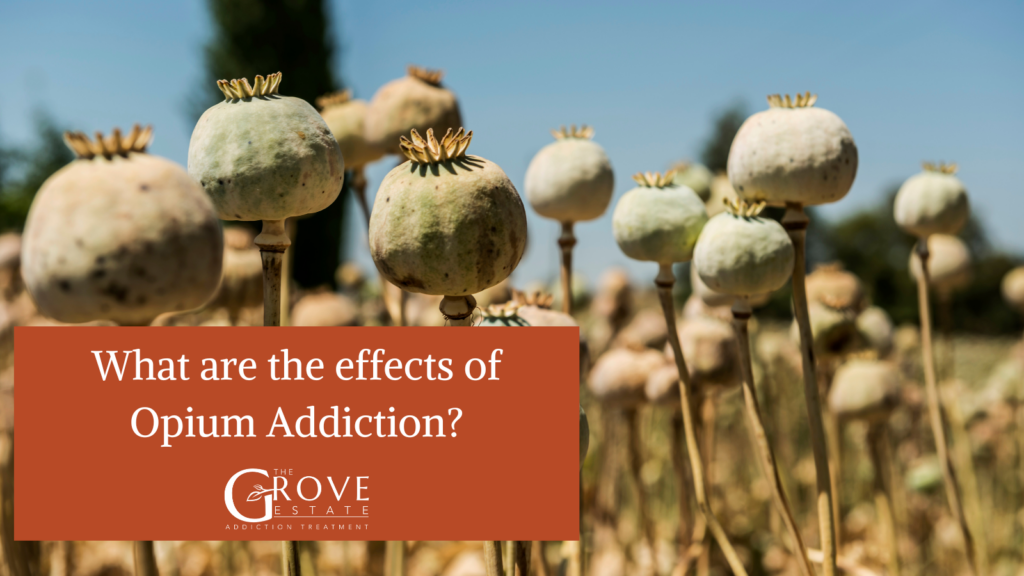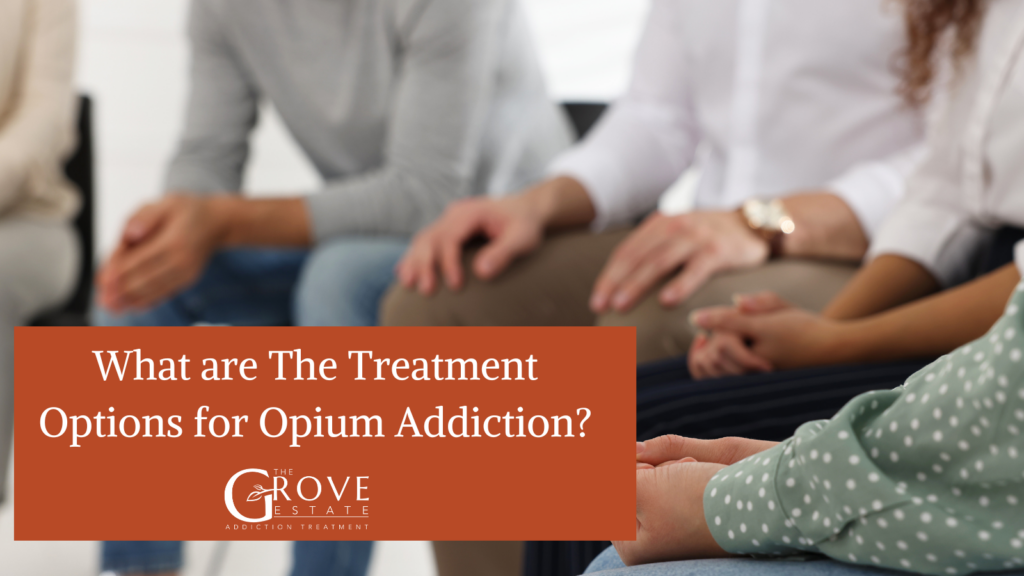Opium addiction is a complex sickness wherein the affected individual has a compulsive urge to use opium. This use continues even when using the drugs negatively affects the person’s physical and emotional well-being. Opium is highly addictive and is classified as a narcotic drug. It is found in the dried latex from the opium poppy (Papaver somniferum) seed pod.
Being a narcotic opium can be prescribed by doctors to help relieve pain. This use along with any illicit uses can result in an opium addiction. Symptoms of an opium addiction can include messy sleep patterns, drug dependence, changes in habits, and several others.
Although the specific cause of opium addiction is largely unknown, genetic predisposition, mental health issues, and stress have been linked to opium addiction in individuals. Treatment of opium addiction is a gradual process that involves detoxification, medication, and therapy.
What is Opium Addiction?
Opium addiction is the continued use of opium even when it physically and emotionally hurts the user. It is a type of substance use disorder. Though its cause is not yet fully understood, contributing factors may include how opioids affect an individual’s brain as well as family history and environmental and lifestyle factors.
What are the symptoms of Opium Addiction?
Opium addiction is a serious condition characterized by a wide range of symptoms. Not every single user will have all the symptoms listed below. These are the symptoms typically associated with opium addiction.
- Physical Dependence: Physiological changes occur with opium use, leading to withdrawal symptoms like cravings and sweating when drug intake is halted. Physical dependence can exist without addiction, as seen in cases of chronic pain management.
- Increasingly Heavy, or Risky Use: Persistent use of opium despite health, safety, financial, or relationship problems, with escalating patterns of consumption. Loss of control over opium use and interference with daily life are common indicators of addiction.
- Cravings: Overwhelming physical and emotional urges to use opium, often persisting despite awareness of potential negative consequences. Cravings can be powerful drivers of continued drug use, making it challenging for individuals to quit.
- Resistance to Acknowledging the Problem: Individuals may deny the seriousness of their substance use disorder and resist seeking help. Denial can prolong the time it takes an individual to recognize the need for assistance.
- Other Signs of Opium Addiction:
- Excessive sleepiness and altered patterns of sleep.
- Weight loss.
- Frequent flu-like symptoms
- Decreased libido
- Lack of hygiene
- Changes in exercise habits
- Withdrawal from social interactions.

What are the effects of Opium Addiction?
Opium, known for its distinct properties, can have profound effects on the human body, and it’s crucial to comprehend the potential risks associated with opium addiction.
Common Opium Side Effects
| Euphoria | Opium use can induce a heightened sense of pleasure and well-being |
| Drowsiness | The sedative nature of opium often leads to extreme sleepiness. |
| Constipation | Opium, like other opioids, commonly causes digestive issues such as constipation. |
| Nausea | Users may experience feelings of queasiness and vomiting due to opium abuse. |
| Dependence | Opium misuse poses a risk of developing a substance dependency. |
Additional Side Effects of Opium
| Dry Mouth | Opium use may result in a sensation of oral dryness. |
| Itching | Persistent itching can be a side effect associated with opium abuse. |
| Abdominal Issues | Gastrointestinal discomfort and related problems may occur. |
Serious Consequences
| Respiratory Suppression | Opium abuse can lead to life-threatening respiratory depression. |
| Potential for Fatality | Prolonged and unchecked opium misuse carries the risk of serious health complications, including death by respiratory failure. |
What are the risks of Opium Addiction?
Prolonged use of opium has the potential to result in opium addiction. This prolonged use allows the individual to get the pleasurable effects of opium. However, over time, these positive sensations tend to diminish. To restore the initial euphoria or, as the condition progresses, to stave off withdrawal symptoms, users will begin to use it more often.
The development of tolerance is another factor in opium addiction. As individuals become accustomed to it, higher doses are required to achieve the desired effects. The fear of withdrawal symptoms also drives more of its use.
Beyond the physiological aspects, psychological and social factors also play a pivotal role. Stress, trauma, and social pressures can influence an individual’s susceptibility to opioid addiction. Additionally, genetic predispositions may contribute to the overall risk of developing substance use disorders. Ducci F and Goldman D. published an article titled: ‘The genetic basis of addictive disorders’ in 2012 that established a link between genetics and addiction.

What are The Treatment Options for Opium Addiction?
Opium addiction is a challenging journey, but various evidence-based treatments can help individuals regain control of their lives. Recognizing the need for tailored approaches, high-quality rehab facilities offer a range of programs to address opiate addiction effectively.
Detoxification
The first step in opium addiction treatment is detoxification. This process involves gradually weaning individuals off the substance. During detox, patients may experience withdrawal symptoms, including increased heart rates, sweating, and, in severe cases, seizures. Professional oversight in a specialized detox facility ensures the safety and completion of the detoxification process before transitioning to the next phase of treatment.
Inpatient and Outpatient Facilities
- Inpatient Treatment: Ideal for severe addiction cases, inpatient treatment involves patients residing in a facility for extended periods. Continuous medical monitoring ensures safety during the recovery process.
- Outpatient Treatment: Suited for those maintaining daily routines or employment, outpatient rehab allows flexibility. It’s a cost-effective option, providing therapy without requiring patients to live on-site.
Family Counseling Programs
Including family members in the recovery process helps foster understanding and support. These programs facilitate open communication, allowing both the recovering individual and their relatives to share thoughts and feelings. Strengthening familial bonds creates a lasting support system post-rehab.
Individual Therapy
Personalized sessions with a therapist provide a private space to discuss sensitive issues. This form of therapy aids in processing emotional aspects of past situations that may have contributed to the development of addiction.
Group Therapy
Encouraging interaction among individuals facing similar challenges, group therapy offers a supportive environment. Participants share their recovery stories, providing mutual encouragement and understanding.
Dual-Diagnosis Therapy
For individuals with co-occurring disorders, such as anxiety alongside substance use disorder, dual-diagnosis therapy addresses both conditions simultaneously for more effective treatment.
Reality Therapy
Preparing individuals for independent living post-rehab, reality therapy involves supervised outings to places like movie theaters and grocery stores. This hands-on approach helps in developing valuable life skills and coping mechanisms for real-world challenges.
How effective are Opium addiction treatments?
The success of therapy for opium therapy is not uniform. The effectiveness of treatment is often influenced by the severity of the disorder and individual differences in response to treatment. Coexisting challenges, such as excessive alcohol use or underlying mental illness, can complicate the recovery process.
In cases where both mental health and opium addiction coexist, a comprehensive treatment approach is essential. This integrated strategy addresses both conditions simultaneously. Additionally, a person’s environment and access to a supportive network of family and friends are important and influence the overall treatment outcome.
The chronic nature of opium addiction becomes especially evident when a patient experiences relapse. This stresses the need for ongoing, long-term support. Environmental factors, including identifying and addressing triggers that contribute to substance use, are integral components of effective treatment plans.
Do you need medication for opium addiction?
Medication may be necessary in the treatment of opium addiction. Medications such as methadone, buprenorphine, and naltrexone are commonly used to help manage withdrawal symptoms and cravings. These medications can assist individuals in the detoxification process and support them in maintaining abstinence during the recovery journey.
What are the withdrawal symptoms of opium addiction?
Common withdrawal symptoms include increased heart rate, profuse sweating, nausea, and, in severe cases, seizures. Individuals may also experience intense cravings for the drug. The severity and duration of withdrawal symptoms can vary based on factors such as the level of dependence, the length of substance use, and individual differences.
Can opium addiction lead to other substance addictions?
Individuals struggling with opium addiction may be at increased risk for developing addictions to other substances, a phenomenon known as poly-substance abuse. This risk may stem from attempts to augment the effects of opium or to alleviate withdrawal symptoms with other drugs. According to health experts, this pattern of use can complicate the addiction and make the recovery process more challenging.
Addressing opium addiction comprehensively often involves considering the potential for other substance use disorders, such as ketamine addiction. Integrating approaches that account for the possibility of multiple substance dependencies is essential. Engaging in drug & alcohol seminars can offer insights into the nature of addiction and provide strategies for managing and recovering from poly-substance abuse.

Share This Post



